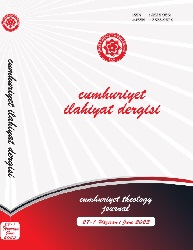Sezai Karakoç’un Eserlerinde Kutlu Söz Kullanımı
The Use of the Holy Word in Sezai Karakoç’s Works
Author(s): İbrahim SaylanSubject(s): Contemporary Islamic Thought, Hermeneutics, Qur’anic studies
Published by: Cumhuriyet Üniversitesi İlahyat Fakültesi
Keywords: Hadith; Sezai Karakoç; Holy Word; Resurrection; Narration;
Summary/Abstract: Sezai Karakoç, one of the most important poets and thinkers of the last period, has developed an ideal by adapting the resurrection in the creed to the resurrection in the world and spent all his efforts to make death before death and resurrection before resurrection dominant over life. Karakoç, whose ideal of seeing it as reviving the Sunnah of the Prophet (pbuh), defined his cause as his own. Although Karakoç intensely dealt with Islamic values and the theme of the prophet in order to enlighten society in his works, he did not prefer to quote directly from religious sources. However, he narrated in some of his works; He attributed them to the Prophet with phrases such as “the Great Prophet said”, “it came in a hadith” or “as the Great Prophet commanded”, and he cited some of them as holy words or as a principle in quotation marks without any direct reference. Since we have dealt with the narrations that Karakoç conveyed by saying that they are hadiths with clear words in another study, only the narrations he narrated as a holy word or a principle were examined in this study. By numbering these narrations, they were first transmitted with the words that Karakoç conveyed, and then the sources and soundness of the narration were determined. In order to understand Karakoç’s purpose in using the narration correctly, the context of the narration and its interpretation are included. In our study, forty-one works of Karakoç have been examined and thirteen narrations have been identified, except for the duplicates. The first of these; The phrase “lā hawla walā kuwwa” came as a part of the verse, and Shaykhān (i.e. Bukhārī and Muslim) and many other narrators conveyed it both independently and as a part of some hadiths. Second; “If you know that the apocalypse will break tomorrow, plant the sapling in your hand!” It is an authentic/sahīh hadith. Third; “God’s help is upon the congregation.” It is stated that his narration is authentic/sahīh and good/ hasen. Fourth; the narration “the wise person is the one who works for the afterlife...” is a good/hasen hadith with close words. Fifth; the narration “If Abu Bakr’s faith were to be balanced with the faith of all people...” is valid and belongs to Omar. Sixth; the narration “whose two days are equal to each other...” is conveyed with a weak/da’īf promissory note. In the sources, it is mentioned that Abdulaziz b. Abī Rawwād and Hasan al-Basrī received it from the Prophet mostly in their dreams. Seventh; “Seek knowledge, even in China.” The narration has no original or is called fabricated/mawdū’ as there is no document that reaches the Prophet. Eighth; “Die before you die.” The narration is not a valid hadith. Ninth; the narration of “being moralised with the morality of Allah” has no basis in hadith, it is one of the words of Zunnūn al-Misrī. These two words are principles accepted by Sūfīs. Tenth; the narration that “the world is the field of the hereafter” has not reached till the Prophet. As far as we can determine, it was Hārizmī who was the first to use it as a wise word. The eleventh; although the narration “to the world as if you will never die...” is not true, It is a mawqūf narration attributed to Abdullah b. Amr. Twelfth; although the narration “I was a hidden treasure...” is included in many tafsir works, it is not included in hadith books. Thirteenth; the phrase “religion is morality” is not a direct hadith on its own, but an inference that has been referred to in many narrations. Considering these 13 narrations, which Karakoç quoted in different contexts without specifying who said them; It is possible to collect these narrations in topics such as seeking the truth, the importance of science, good morals, struggle with the nafs, preparation for death and asceticism. In terms of the validity of these narrations these can be said: 3 of them are authentic/sahīh, 1 of them is hasen/good with close words, and 3 of them are weak/da’īf. One of the weak/da’īf narrations was accepted as the word of the Companions. Other narrations are that it was accepted as a fabricated/mawdū’ because there were no enactments reaching the Prophet. Again, one of these narrations is mentioned as the word of Abdullah B. Amr. Others are the principles and wise words accepted by Sūfīs and were referred to as if the Prophet had said them over time. Based on these data it can be said that some Sūfīs did not show the necessary diligence in preserving the hadiths and that the words of someone else entered our culture as hadiths over time. Since Karakoç was influenced by some Sūfī figures in his works, he sometimes mentioned names such as Gazzālī, Ibn al-’Arabī, Rūmī, Imam Rabbānī, Hacı Bayram-ı Velī, Ahmad al-Rifāī. Karakoç did not use footnotes and a bibliography in his works. When we consider the narrations conveyed by Karakoç, it is understood that he benefited from compilations, not basic hadith sources. It can be said that Karakoç did not see the authenticity of the narrations as a problem because he adopted a cultural and public working method, not a scientific study, and he tried not to attribute the narrations that he was not sure of to the Prophet. It can be said that what Karakoç means by the concept of the holy word is mainly hadith or it is included as hadith in his sources, and it is a kind of cultural narration.
Journal: Cumhuriyet İlahiyat Dergisi
- Issue Year: 27/2023
- Issue No: 1
- Page Range: 17-29
- Page Count: 13
- Language: Turkish

